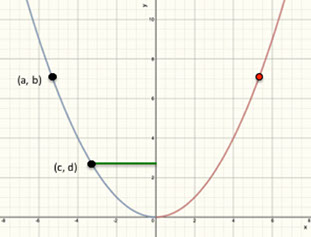Home
Episode 3 Supports
Episode Description
Reflecting: Keoni and Sasha compare the equations for two parabolas: y = x2/8 and y = x2/4. They make two different conjectures about the equation for a parabola with a focus at 3 units above the vertex.
Students’ Conceptual Challenges
With only two equations, differing patterns can emerge that might not work in the general case.
- Sasha and Keoni offer two different conjectures for the equation of a third parabola: y = x2/12 and y = x2/16 [1:16-1:45]. They resolve their differences in Episode 4.
- Sasha and Keoni offer two different conjectures for the equation of a third parabola: y = x2/12 and y = x2/16 [1:16-1:45]. They resolve their differences in Episode 4.
Focus Questions
For use in a classroom, pause the video and ask these questions:
1. [Pause video at 0:57]. Take a moment to examine the focus and directrix that Sasha just drew. When the vertex of the parabola is on the origin, how are the positions of the focus and directrix related?
2. [Pause video at 1:09]. What are your conjectures about the equation for the third parabola?
Supporting Dialogue
Provide opportunities for productive disagreement by asking:
- Keoni and Sasha have two conjectures. Who thinks the next parabola will have an equations of y = x2/16? Who thinks the equation will be y = x2/12?
- Can we have one person to defend the first conjecture? What about someone for the other? Let’s hear each case.
- Keoni and Sasha have two conjectures. Who thinks the next parabola will have an equations of y = x2/16? Who thinks the equation will be y = x2/12?
Math Extensions
1. The graph below represents the equation y = x2/4 . Consider the part of the graph colored blue. Label some coordinates of points on the blue part of the graph. What is common about the coordinates of every point on the blue part of the graph?
2. Notice the point (a, b) on the graph. Represent the coordinates of the red point using the a and the b. Explain your thinking.
3. Notice the line segment shown in green. In mathematics, it is a convention to represent distances with positive numbers. Coordinates can be negative, but distances and lengths must be positive. How can you use the coordinates to represent the length of the green line, which is the distance from the blue parabola to the y-axis?

Mathematics in this Lesson
Lesson Description
Targeted Understanding
CC Math Standards
CC Math Practices
Lesson Description
Keoni and Sasha determine a general method for representing the equation for a parabola with a vertex on the origin and a focus p units above the vertex.
Targeted Understandings
This lesson can help students:
- Interpret the meaning and use of an equation that they derive to represent a family of parabolas with vertex at the origin and focus p units above the vertex (y = x2/(4p)).
- Conceive of the parameter p in the equation y = x2/(4p) as a distance between the vertex and focus of a parabola. The value of p can vary, but once it is set (e.g., when p = 2), then an equation is defined (e.g., y = x2/8) that represents a unique parabola.
- Relate geometric features of parabolas to elements of corresponding equations. For example, the equation y = x2/8 can also be expressed as y = x2/(2•4), where the 2 represents the number of units between the focus and vertex of the parabola.
Common Core Math Standards
• CCSS.M.HSG.GPE.A.2: Derive the equation of a parabola given a focus and directrix.
In Episode 6, Sasha and Keoni derive the equation (in two forms) for the family of parabolas with vertex (0,0) and focus p units above the vertex, namely y = x2/(4p) and x = √(4py). They do this by generalizing the method they used to develop an equation for a parabola with p = 1 in Lessons 3 and 4 (y = x2/4 and x = √(4y)), for a parabola with p = 2 in Episode 2 of this lesson (y = x2/8 and x = √(8y)), and for a parabola with p = 3 in Episode 4 (y = x2/12 and x = √(12y)).
• CCSS.M.HSA.APR.A.1: Perform arithmetic operations on polynomials.
Sasha and Keoni multiply binomials, such as (y + 2)2 and (y + p)2, in service of deriving an equation for a particular parabola (in Episodes 2 and 4) or a family of parabolas (Episode 6).
Common Core Math Practices
CCSS.Math.Practice.MP7. Look for and make use of structure.
In this lesson, Sasha and Keoni make use of mathematical structure on two levels. First, they discern a pattern relating the equations of three parabolas (y = x2/4, y = x2/8, and y = x2/12) with the corresponding distance between the vertex and focus (respectively, p = 1; p = 2; and p = 3). Specifically, they see the structure of 1•4, 2•4 and 3•4 in the denominators of their equations, which is the p-value of the parabola multiplied by 4. Consequently Keoni and Sasha conjecture that the general equation of a parabola with vertex (0,0) and focus p units above the vertex will be y = x2/(4p). Then they look for and make use of structure on a second level. To derive the equation y = x2/(4p), they need to identify the lengths of the sides of a right triangle with hypotenuse connecting a general point on the parabola with the focus. To accomplish this challenging task, Sasha and Keoni see a pattern in similar quantities that they identified for particular parabolas, which they generalize to define lengths involving the parameter p, such as y – p and y + p.



















